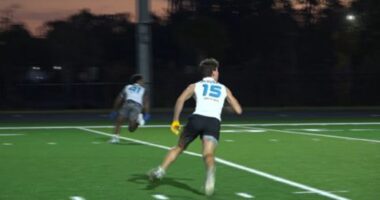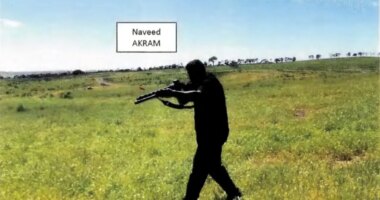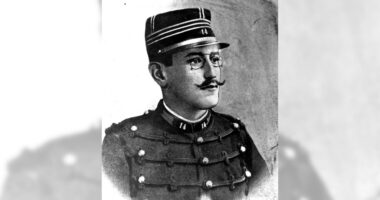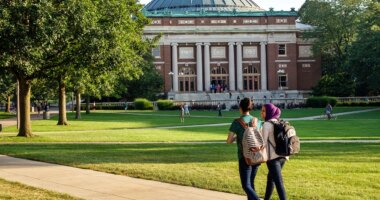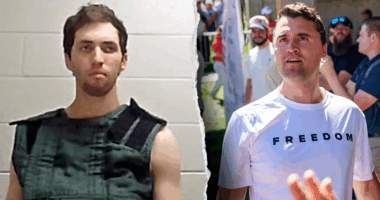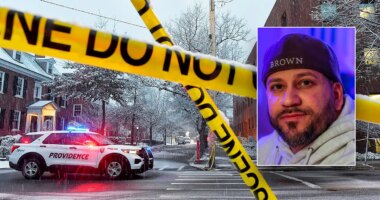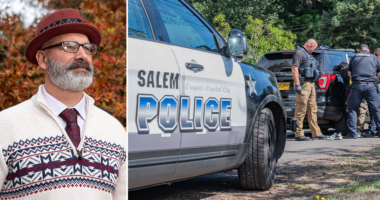Share this @internewscast.com
EDGING open the door to the student digs, Hunter Johnson felt something was amiss – but he could never have anticipated the horrific scene he was about to encounter.
On the floor, in pools of blood, lay the bodies of two of his closest friends, Ethan Chapin, 20, and Xana Kernodle, 20 – victims of a frenzied knife attack.
The bodies of two more classmates, best friends Maddie Mogen, 21, and Kaylee Goncalves, 21, lay in a nearby room,
The gruesome murder of the four friends in the early hours of November 13, 2022, shocked the nation and sent waves of panic through the otherwise quiet, small-town community of Moscow, Idaho.
And last week, 30-year-old criminology PhD student Bryan Kohberger confessed to carrying out the killings, after two long years of denial.
Now, the full story is revealed in the new Amazon docuseries One Night in Idaho: The College Murders, with accounts from fellow students, housemates and families of the victims as well as chilling insights into the twisted games killer Kohberger played after the massacre.
It was in the early hours of the morning that housemate Dylan Mortensen awoke to the sound of a muffled commotion upstairs – and then the terrifying sight of a man walking past her bedroom door.
In this half-asleep haze, she made a frightened dash to her friend Bethany’s room in the basement.
But, come the morning, she realised what she’d seen was no dream.
When their fellow housemates weren’t answering their phones, the two girls made a desperate call to friends Hunter Johnson and Emily Alandt, who lived just round the corner.
“I don’t think I’ve ever locked a single door in Moscow. When Dylan had called, I didn’t think it was urgent, so I started walking to Xana’s house, and when we got there, Dylan and Bethany had exited the house,” recalled Emily.
“They looked frightened, just hands on the mouth like, ‘I don’t know what’s going on’ type of thing.”
Hunter Johnson bravely went up the stairs to the room on the second floor.
There he found the blood-soaked bodies of his closest friend Ethan, and girlfriend Xana.
To protect the others from what he had stumbled upon he ushered them out of the house and urged them to call 911.
Crime scene tape now surrounded the house, but the cops weren’t giving answers.
And housemates Maddie and Kaylee still weren’t answering their phones.
Panic Spreads
Ethan’s twin brother, Hunter, who also attended the University of Idaho, recalled the moment he found out what had happened to his beloved brother.
“They all just had this look on their face, like the world had ended,” he said.
“‘Where’s Ethan?’ I asked. And they’re like: ‘Ethan’s not here anymore’.
“I couldn’t face the fact that he was dead.”
Maddie’s boyfriend then called her mum, Karen, informing her there’d been a homicide at her house.
She called the police, who had no answers – so she headed straight to the town.
“The whole time, my mindset was we’re going to pick up Maddie and Kaylee and bring them home, console them and hug them and figure out just what happened,” she said.
But it was a hug she would never get to give.
At that moment, phones in the town pinged with an alert sent straight from the local police department – revealing the fate of the two missing girls.
“Moscow Police continue to investigate the death of four people near campus,” it read.
Four of their best friends were dead.
But there were no arrests, no suspects, and why they had been so horrifically murdered was a mystery.
We were just sitting in the sliding doors of this hotel lobby, just crying out loud
Jim Chapin
“We got to the police department, I remember running up the stairs and just trying to find anyone to talk to,” Maddie’s mum Karen said when she found out her own daughter was dead.
“The officer explained there had been a homicide in your daughter’s house, and that there are four victims.
“Instantly we were like ‘that didn’t make sense.’ And he said, ‘Maddie was a victim’.”
Jim Chapin, Ethan’s father, recalls the families’ reaction after the police confirmed the victims’ names: “We were sitting by the sliding doors of this hotel lobby, just crying out loud.”
Online hate
It had been at least six years since a homicide in the town, so police were ill-prepared to deal with the deluge of media attention they now found themselves under.
Cops refused to hold interviews or press conferences and rumours soon filled the vacuum. 1122 King Road was known for being a party house, and there was speculation that drug use was rampant, that it was an overdose that killed them.
Then things turned even more sinister.
“It came like a freight train out of nowhere,” said David Berriochoa, a friend of the victims.
Amateur sleuths were posting to Tiktok and YouTube with their theories – and they were trawling through the often public accounts of the victims and those close to them to find out more.
Often, all it took was a photo with the deceased for conspiracies to start snowballing.
Grieving friends like David and Hunter were accused of being the killers, while strangers searched for reasons to blame Dylan and Bethany, the surviving housemates.
“My inbox was full, just the worst, most heinous things I had ever read,” said David.
‘I hope you fry,’ one message said, while information about his address, car, and parents’ workplace were posted online.
“I was once again fearing for my life – but for a completely different reason,” he added.
Some even dressed up as students to gain access to the dorms, and the house 1122 King Street – became a ghoulish tourist attraction.
I lost a best friend. People thought I killed him
Hunter Johnson
A video of Hunter Johnson with zip ties round his wrists – which was actually for a drinking game – led online detectives to brand him “zip tie guy” and accuse him of the killing.
“I lost a best friend. People thought I killed him. That was really depressing to me,” says Hunter.
Evil taunts
Weeks had gone past, and there were still no answers.
Groups on Facebook sprung up with hundreds of thousands of members posting questions and theories about what happened.
But on the University of Idaho Murders – Case Discussion forum, one poster’s creepy questions struck an eerie note.
Going by the name Pappa Rodger, he had an unusual fascination with the details of the crime scene, asking things like “Which hand do you think they used to kill with?” and “Did the killer shower at the crime scene afterwards?”.
Local police had announced that they were looking for a White Hyundai that had been spotted driving past the property twice the day of the murders, shortly before and then at around 9am the same morning.
“I feel like the white car isn’t relevant,” wrote Pappa Rodger. “It’s a red herring.”
It turned out that this was no coincidence.
Seven weeks after the murders, police arrested criminology student Bryan Kohberger, who was living just a 15 minute drive away in Pullman, Washington.
He had left behind the knife sheath, which allowed investigators to match his DNA.
Phone data and his connection to the white Hyundai further confirmed to police that they had the man they were after.
And the moment he was arrested, all traces of Pappa Rodger disappeared.
Friends of the victims were baffled. Kohberger was unknown to everyone – a nobody who, as far as they were away, they had never crossed paths with.
“Any theory that I had was just thrown out the door,” said Hunter.
He’s smart, but he’s like a robot
Josh Ferraro
But to those who knew Kohberger, his arrest wasn’t that surprising.
Prior to studying in Washington, Kohhberger was in forensic psychology classes at a university in Pennsylvania.
He seemed a lonely guy – so classmate Josh Ferraro made an effort to get to know him.
“He was an oddball,” Josh remembered.
“He’s smart, but he’s like a robot, purely based off the fact of his social inability to perform in a normal human manner.
“I can absolutely see someone like him being involved in something like this.”
Sick obsessions
Classmates remember him for being a top student, but obsessed with the likes of Ted Bundy and Jeffrey Dahmer.
Yet, through his choice of subject, Kohberger had a free pass to delve into serial killers and their motives without raising suspicion.
And the lessons he learnt in university no doubt helped him to murder the four young students in Idaho.
Prosecutors filed for the death penalty, but on July 2, Kohberger finally admitted guilt in a plea deal that will see him avoid death row.
Still unknown, however, is why this random – yet seemingly targeted – attack was carried out at all.
But many suspect this was a case of an incel killing – a hateful lashing out against women by a man desperate for their attention.
Kohberger had long been known to have trouble with women.
He once went on a date with a girl, and insisted on walking her back to her dorm, where he kept trying to tickle her. After their date, he texted: “You have good birthing hips.”
Altercations with students had even led to him being fired from his teaching position just days before he was arrested.
There’s never a moment in my life now where the thought of Ethan not being here isn’t there
Hunter Chapin
Kohberger also seemed to have a particular fascination with Elliot Rodger, the “incel killer” who killed six in a mass shooting in 2014.
There are eerie parallels – including Kohberger’s Facebook name, “Pappa Rodger”.
One of the girls killed by Kohberger, Maddie, was also in the same sorority that Elliot Rodger had intentionally targeted.
The truth may never be revealed.
But for those who knew Maddie, Kaylee, Ethan and Xana, it’s a day that changed their lives forever.
“There’s never a moment in my life now where the thought of Ethan not being here isn’t there,” said Hunter.
“It’s something that I don’t think will ever go away.”
Karen, Maddie’s mum, added: “How would Maddie and Kaylee want to see me?
“Would they want to see me crying in my pyjamas, and unable to get out of bed? Or would they want to see me talking about them and how happy and amazing they are?
“You never know how strong you are until strong is all you can be.”
One Night in Idaho: The College Murders is available on Amazon Prime Video now











